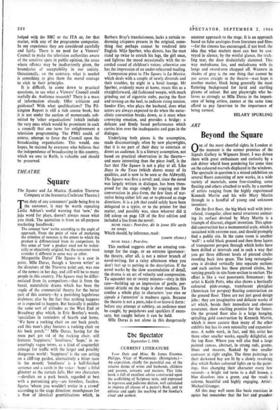Beyond the Square
ART On the first floor, the big black wall with inter- related, triangular, silver metal structures animat- ing its surface devised by Mary Martin is a triumph of discreet, elegant invention. This splen- did construction has a monumental scale, which is sustained with extreme ease, and should promptly find a public site. In the same room is another 'wall': a solid black ground and then three layers of transparent perspex through which holes have been drilled at intervals and in such a way that you get three different levels of pierced circles receding back into space. The long rectangular area is divided vertically into separate sections and each section has these pierced circles, but varying greatly in size from section to section. The effect is like a vast panoramic firmament: the artist is Keith Potts, who also shows a hectically coloured pink-orange, translucent plexiglass (American for perspex) floating construction on the ground floor. These are not just good design jobs : they are imaginative and delicate works of art which, beside their immediate and obvious assurance, show exciting promise for the future. On the ground floor also is a large hanging, spiralling gold construction by Kenneth Martin, which is more austere than many of the other exhibits but has its own sensuality and expansive- ness. A noble work, in fact, and this artist has three other smaller works, equally delightful, on the top floor. Where you will also find a large painted canvas, abstract, in strong reds, greens, blues and mauves, flanked by two smaller canvases at right angles. The three paintings in their darkened bay are lit by a slowly revolving disc which flashes coloured lights on to the paint- ings, thus changing their character every few seconds—a bright red turns to a dull brown, a blue dissolves into a green, and the result is solemn, beautiful and highly engaging. Artist: Michael Granger.
All this may well seem like basic exercises in optics but remember that the last and grandest
works of Matisse, which have affected artists everywhere in the past decade, were made of coloured bits of paper stuck on to a plain white ground: materials which children use at school when they're about five years old. (There's a good example currently on loan at the Tate.) The point of a lot of the exhibits at Signals is that they force you to think again about angles of vision and con- ditions of visual experience which we all imagine we know backwards but often don't.
There is much else to explore at the Signals gallery: notably a 33-feet long wall of broad coloured vertical stripes by Peter Joseph, a plea- sure to the eye, not particularly profound, maybe, in the slightly mystical sense of Albers or Stella, but again eminently deserving a public site and immaculately and lovingly executed.
The same applies to the works by John Wells, as well as to the angular paintings by Fred Bazler in which expanding strips radiate outwards from the corner so that an over-all fan shape disrupts the containing diamond or square. Near by some small painting by Calderara, an Italian compatriot and friend of Fontana, exemplify what I mean by a more soulful sense of colour in the sense of Albers—or, in this case, Ad Reinhart.
Work exploring similar territory can be found in the new and equally dedicated Indica Gallery in Mason's Yard, St James's, close to a well-known pop-group club. But here the show, currently by Gerald Fitzgerald; has a slightly more provisional nature caused, I imagine, largely by lack of money. Coloured cardboard shapes are distri- buted on the floor and against walls, and they
probably should be carried out in more perma- nent materials—which can be costly. Otherwise, Fitzgerald is showing a number of small works on paper which has been creased, crinkled and systematically surfaced as a ground for very fine, evenly applied, densities of colour—not unlike Mark Tobey's constellations. The colour has an edge because it comes from oil crayons which have a particularly sharp kind of colour. Again, apart from the beauty of these 'activations' (artist's phrase), Fitzgerald is investigating materials and methods, rubbing, hammering, scraping, etc.). A small square area of rippling grey foam rubber is encased by polythene which, when pressed against the rubber, flattens it out, destroying the ripples, producing a new colour, formal area, and texture, and this is typical of Fitzgerald's activities.
The Indica Gallery and the older Signals centre are doing pioneer work in London. Paul Keeler has backed Signals from the beginning and is doing for a large number of artists, on an inter- national scale, what Kahnweiler did for the cubists in Paris. Guy Brett, a deeply committed (and sensible) critic has helped the campaign. The forces at work in the campaign as a whole are varied and often quite separate; and as even the more sophisticated sections of the art public seem fairly woolly about the shades of refinement between optical art, kinetic art, environmental painting and sculpture, and visual research as a whole, I hope to offer readers a straightforward guide to these lively movements in the near future.
BRYAN ROBERTSON































 Previous page
Previous page